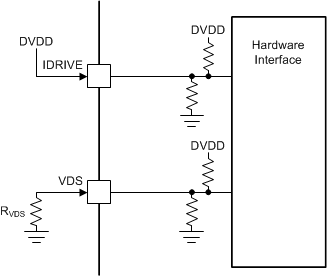SLVSE38A April 2018 – July 2018 DRV8306
PRODUCTION DATA.
- 1 Features
- 2 Applications
- 3 Description
- 4 Revision History
- 5 Pin Configuration and Functions
- 6 Specifications
-
7 Detailed Description
- 7.1 Overview
- 7.2 Functional Block Diagram
- 7.3
Feature Description
- 7.3.1 Three Phase Smart Gate Drivers
- 7.3.2 DVDD Linear Voltage Regulator
- 7.3.3 Pulse-by-Pulse Current Limit
- 7.3.4 Hall Comparators
- 7.3.5 FGOUT Signal
- 7.3.6 Pin Diagrams
- 7.3.7 Gate-Driver Protective Circuits
- 7.4 Device Functional Modes
- 8 Application and Implementation
- 9 Power Supply Recommendations
- 10Layout
- 11Device and Documentation Support
- 12Mechanical, Packaging, and Orderable Information
Package Options
Mechanical Data (Package|Pins)
- RSM|32
Thermal pad, mechanical data (Package|Pins)
- RSM|32
Orderable Information
7.3.1.2 Hardware Interface Mode
The DRV8306 device supports a hardware interface mode for simple end-application design. In this hardware interface device, the VDS overcurrent limit and the gate drive current levels can be configured through the resistor-configurable inputs, IDRIVE and VDS. This feature lets the application designer configure the most commonly used device settings by tying the pin logic high or logic low, or with a simple pullup or pulldown resistor.
The IDRIVE pin configures the gate drive current strength. The VDS pin configures the voltage threshold of the VDS overcurrent monitors.
For more information on the hardware interface, see the Pin Diagrams section.
 Figure 10. Sample Configuration of Hardware Interface
Figure 10. Sample Configuration of Hardware Interface